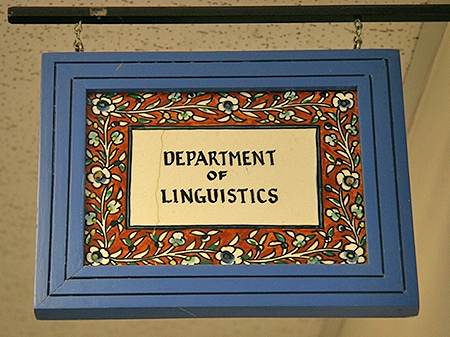
Linguistics ETDs
Publication Date
5-1-2016
Abstract
This study investigates the relationship between three linguistic functions: thetics, miratives and exclamatives. Thetics are an information structure configuration that conveys that the information is new to the addressee. The thetic subtypes selected for this study are the following: existentials (e.g. There are apples in the kitchen); presentatives (e.g. Heres your book); weather statements (e.g. It rains); physical sensation statements (e.g. My HEAD hurts) and hot news (e.g. MIchael JACKson died). Thetics do not perform a predication but present the state of affairs as a whole. Crosslinguistically, they tend to use morphosyntactic strategies that distinguish them from prototypical predications. Similar morphosyntactic strategies can also be found in miratives and exclamatives. Miratives are defined as grammatical markers that convey that the information is suprising for the speaker, whereas exclamatives are defined as a sentence type that conveys surprise with respect to a scalar extent that has surpassed the current expectations (e.g. How beautiful you are!). I hypothesize that the structural similarities between these functions are motivated by semantic resemblance. The structural features of these functions are compared in a sample of 76 languages, from which 360 constructions were extracted. Multidimensional scaling was used in order to construct a spatial representation of the degree of similarity/dissimilarity of the constructions. The resulting spatial map shows a dimension motivated by a semantic distinction between event-central and entity-central statements. It also shows a second dimension motivated by the following distinctions: 1) an existential domain, 2) a presentational domain, 3) a mirative domain, and 4) an exclamative domain. Several case studies illustrating the relationships between the functions are presented. It is also demonstrated that miratives can establish a distinction between unexpected and misexpected events. As for exclamatives, it is shown that they are related to linguistic hedges that convey the degree of membership of an item into a category. Several neurobiological and psychological correlates are proposed: thetics correspond to two types of awareness, whereas miratives and exclamatives are related to different stages of a cognitive-evolutionary model of surprise.
Language
English
Keywords
Information Structure, Sentence Types, Surprise, Linguistic Typology, Theticity, Mirativity, Exclamativity
Document Type
Dissertation
Degree Name
Linguistics
Level of Degree
Doctoral
Department Name
Department of Linguistics
First Committee Member (Chair)
Axelrod, Melissa
Second Committee Member
Cristofaro, Sonia
Third Committee Member
Vallejos Yopan, Rosa
Recommended Citation
Garcia Macias, Jose Hugo. "From the Unexpected to the Unbelievable: Thetics, Miratives and Exclamatives in Conceptual Space." (2016). https://digitalrepository.unm.edu/ling_etds/11

Comments
Submitted by Jose Hugo Garcia Macias (jhgarcia@unm.edu) on 2016-04-15T16:36:11Z No. of bitstreams: 1 GarciaMacias_Dissertation.pdf: 10569243 bytes, checksum: 6949be02f12f30ee18a1d93cdbc4842c (MD5), Approved for entry into archive by Doug Weintraub (dwein@unm.edu) on 2016-06-09T18:33:05Z (GMT) No. of bitstreams: 1 GarciaMacias_Dissertation.pdf: 10569243 bytes, checksum: 6949be02f12f30ee18a1d93cdbc4842c (MD5), Made available in DSpace on 2016-06-09T18:33:05Z (GMT). No. of bitstreams: 1 GarciaMacias_Dissertation.pdf: 10569243 bytes, checksum: 6949be02f12f30ee18a1d93cdbc4842c (MD5)